William Davis's Blog: Dr. Davis Infinite Health Blog, page 143
March 14, 2015
Skin: a reflection of internal and overall health

Here are the photos that Liz shared showing her before Wheat Belly and after Wheat Belly changes in her skin–pretty dramatic changes.
Of course, skin is an organ that is readily visible unlike, say, the liver or colon. The skin is an important reflection of body-wide health, not just skin. Because Liz experienced such a dramatic change in skin health, it is very likely that it was paralleled by improvements in gastrointestinal, metabolic, and immune health–all achieved by removing wheat and grains.
What was that they were saying about the Wheat Belly lifestyle being nothing more than a low-carb diet?
The post Skin: a reflection of internal and overall health appeared first on Dr. William Davis.
March 13, 2015
Wheat Belly meals and flours for baking
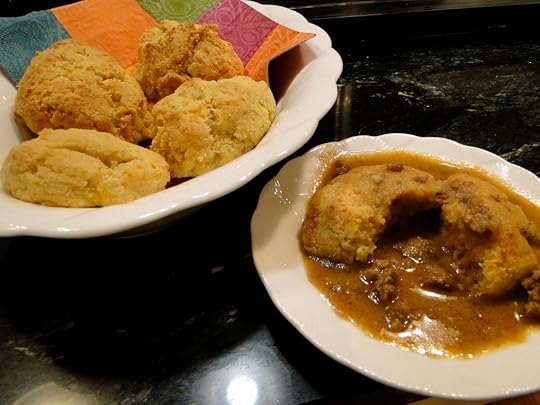 So you kiss all things wheat and grains goodbye. And you’ve come to learn that gluten-free foods made with replacement flours like cornstarch, tapioca starch, potato flour, and rice starch are also very destructive, since they make visceral fat grow, send blood sugar through the roof, and contribute to diabetes, hypertension, heart disease, cancer, and dementia. (If these gluten-free food manufacturers persist in pushing gluten-free foods made with these awful ingredients, I’m going to have to write a new book: “Gluten-Free . . . Fat, and Diabetic“!)
So you kiss all things wheat and grains goodbye. And you’ve come to learn that gluten-free foods made with replacement flours like cornstarch, tapioca starch, potato flour, and rice starch are also very destructive, since they make visceral fat grow, send blood sugar through the roof, and contribute to diabetes, hypertension, heart disease, cancer, and dementia. (If these gluten-free food manufacturers persist in pushing gluten-free foods made with these awful ingredients, I’m going to have to write a new book: “Gluten-Free . . . Fat, and Diabetic“!)
But perhaps you’d sure like a few muffins or cookies once in a while . . . without paying a health price.
What “flours”–non-wheat and without gluten-free junk carbohydrates–are truly safe and provide reasonable baking characteristics? Here’s my list, the flours I use in my recipes:
Almond meal–Also called just “ground almonds,” the meal ground from whole almonds is versatile and yields a great texture, though heavier than wheat-based flour. Shop around, as prices vary widely. Where I live (Milwaukee, Wisconsin), I can pay anywhere from $4 to $18.99 per pound from local grocery stores.
Almond flour–Almond flour refers to flour ground from blanched almonds that may or may not have had the excess oil pressed from it. This yields a fine flour but minus much of the fiber. It is also more costly. I therefore reserve the use of almond flour for dishes where a lighter texture is required, e.g., layer cake.
Ground pecans–A coarser flour than that from almonds, ground pecans can be used in place of almond meal or flour. Ground pecans are my preferred choice to create pie crusts. Anyone allergic to almonds may find ground pecans useful.
Ground walnuts–Similar to ground pecans, ground walnuts are coarser and best used as pie crust or in recipes in which a coarse texture is acceptable, e.g., scones. As with ground pecans, ground walnuts may be useful for almond-allergic individuals.
Coconut flour–The flour ground from coconut meat has a wonderful taste and scent (surprisingly not coconutty, for those of you who do not like coconut). However, it yields an exceptionally dense and hygroscopic (water-absorbing) product. It is so water-absorbent that it can even become lodged in the throat if used as the sole flour. I therefore prefer to use it–for both texture and safety–as a secondary flour to modify the taste and texture of a primary flour, such as almond meal, and to add structure to the final product. Typically, I use 8-12 parts almond meal to no more than 1 part coconut flour, e.g., 2 1/2 cups almond meal + 1/4 cup coconut flour.
Ground golden flaxseed–It’s the golden flaxseed you want, not the more common brown, when you desire a flour replacement. The golden yields a finer texture. Used by itself, the ground golden flaxseed tends to be too crumbly, so it is best used as a secondary flour along with almond meal or other nut meal.
Pumpkin seed meal–Easy to grind, pumpkin seed meal is dense and oil-rich and thereby tends to yield a denser end-product.
Sesame seed meal–Sesame seeds yield a surprisingly light flour. I’ve been making sesame seed crackers with ground sesame meal, whole sesame seeds, mustard powder, onion powder, garlic powder, and cayenne pepper to dip in hummus–wonderful. Buy your sesame seeds in bulk, not the costly small quantities in the spice aisle. Also, choose the lighter varieties.
Sunflower seed meal–Like pumpkin seed meal, sunflower seed meal yields an oil-rich and dense flour replacement. It also confers a unique green color (perfectly healthy and due to chlorophyll, just like spinach or broccoli).
Garbanzo bean flour–While legumes tend to be high in carbohydrates, garbanzo bean (AKA “chickpea”) is among the lowest of the various bean flours available. Yeah, sure, there’s the phytate anti-nutrient issue with garbanzo beans, but if consumed occasionally as a flour it is not a practical concern. Like coconut flour, I find garbanzo bean flour useful as a “lightening” flour to make nut flours a bit lighter and less dense.
Chia seeds and meal–Use chia, either whole or ground, when a very dense end-product is acceptable. Given its great absorptive capacity, chia will also increase need for liquid and sweeteners. (I actually find chia most useful in smoothies and making jams, less useful for baking, but I list it here for completeness.)
There are indeed many other flours and meals you can purchase or grind yourself, but I’ve crossed those off the list for a variety of reasons, such as the unacceptably high carbohydrate content of chestnut flour, teff flour, amaranth flour, and sorghum flour (not to mention that the latter three are grains with problems beyond carb content).
And don’t sweat the linoleic acid/omega-6 content of these flours. Contrary to some silly conversations that circulate online, complete avoidance of omega-6 oils is unhealthy, even fatal. We just need to avoid the grotesque overexposure to omega-6 fatty acids that develops when you use oils such as safflower and corn oil while consuming modern processed foods made with these oils. The modest omega-6 exposure in, say, almond meal that is mostly monounsaturated fats with some omega-6 oils, adds to the modest omega-6 quantities from meats and other foods, but does not result in overexposure. Have your three egg omelet, for instance, with olive oil, spinach, and mushrooms, some bacon or sausage, followed by a couple of chocolate chip cookies. You’ve obtained saturated fats (which we do not avoid), monounsaturated fats, and some omega-6s, and you will come out just fine.
The post Wheat Belly meals and flours for baking appeared first on Dr. William Davis.
March 12, 2015
Susan looks different off wheat–and cured husband’s diabetes
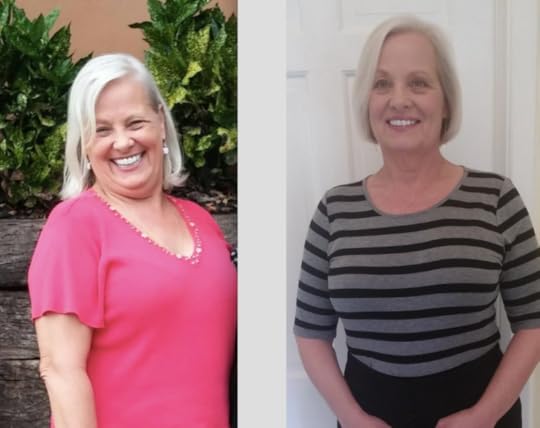
Susan shared her wonderful photos and story of her Wheat Belly lifestyle. But she also showed how she–not the doctor!–helped reverse her husband’s diabetes!
I’ve only lost 15 pounds….but what a difference! And, even though I didn’t lose weight right away, my face and body looked different after 2 weeks. It was the energy and feeling of well being that kept me going and the fact that my husband wasn’t having to take shots anymore.
I started Wheat Belly in august and I felt so much better immediately that, after a couple of days, my husband said he was going to try it, too. I made sure I had plenty of muffins and good things made for him so he would stick with it.
He took 2 shots of insulin a day for 8 years. After starting Wheat Belly, his blood sugar stayed below 100. His last A1C was 5.4%. His doctor said technically he is no longer diabetic, but we know if we ate differently he would be diabetic again. He is off of his insulin, high blood pressure meds, sleeping pills, and Prilosec. We have more energy than we’ve had in years and love our new way of life. My skinny husband lost 20 pounds immediately and I only lost 1/2 pound in 5 months. Then 15 pounds fell off in a month. (But I also have thyroid problems). I praise Wheat Belly to everyone I see!
Susan truly looks different, as well as feels different, off wheat and grains. And she has extended her husband’s life by at least several years while sparing him the discomfort, hassle, expense, and long-term complications of diabetes. What is so wonderful about Susan’s story is that she accomplished this on her own without her doctor, after the doctor had essentially resigned her husband to a lifetime of drugs and diabetic complications.
Now, Susan: get that thyroid addressed!
The post Susan looks different off wheat–and cured husband’s diabetes appeared first on Dr. William Davis.
March 11, 2015
Skin changes with the Wheat Belly lifestyle
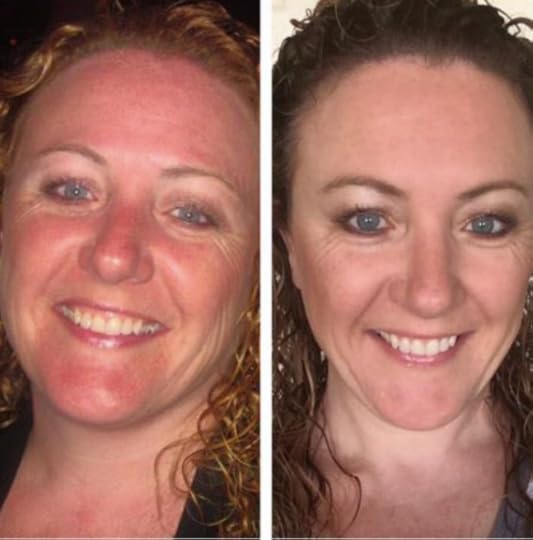
Dawn shared her photos of the facial changes she experienced with her Wheat Belly lifestyle.
Left = summer, 2013. Right = today. Started Wheat Belly March 20th, 2014. Lost 25 lbs by July and have maintained ever since. I can’t say enough about this lifestyle.
Beyond the 25 pound weight loss, what I find striking are the changes in Dawn’s skin: the redness is gone and there is visibly less facial edema. Dawn looks dramatically different minus wheat and grains.
We see this with some frequency around here and it reflects the loss of body-wide inflammation, though evident on the skin. Inflammation on the skin is often paralleled by inflammation of the gastrointestinal tract. Though she doesn’t elaborate, I’d be willing to bet that Dawn also experienced some important improvement in gastrointestinal symptoms, especially acid reflux, bowel urgency, and bloating.
Regardless, you can appreciate just how dramatic the change has been for Dawn’s appearance. This is yet another example of how eliminating wheat and grains from the diet does not just achieve substantial weight loss, but also yields outsized improvements in health–because they never belonged in the human diet in the first place.
The post Skin changes with the Wheat Belly lifestyle appeared first on Dr. William Davis.
March 9, 2015
Another characteristic wheat/grain sign
Julie shared these photos of her ankle before and after wheat/grain/gluten exposure.
My ankle on a 3 month gluten binge:

My ankle after returning to sanity for just 4 days:

It’s an odd phenomenon, but the red, inflamed, swollen ankle Julie had while eating wheat/grains/gluten is quite common, especially among women. It is typically also accompanied by hypertension and the signs of metabolic syndrome, including low HDL, high triglycerides, high blood sugar/pre-diabetes, increased measures of inflammation. You can also make out the water retention evidence in Julie’s ankle on the “before” photo, largely gone after just 4 days in the “after” photo.
Once again, wheat/grain elimination is not about cutting calories or cutting carbs; it is about eliminating a highly inflammatory collection of proteins from the human diet.
The post Another characteristic wheat/grain sign appeared first on Dr. William Davis.
Depression: Why not START with a nutritional solution?

If you experience depression, you will typically be prescribed an antidepressant, an SSRI or other agent. If you consult a psychologist or counselor, the underlying psychological underpinnings (if any) are explored, strategies devised to cope. But there will almost never be talk about your diet, nutritional deficiencies that amplify dark moods, the life habits that allow demons to emerge.
Yet there are some very powerful strategies available that have potential to substantially lift mood. Such solutions won’t, of course, erase the effects of childhood trauma or grieving from personal loss, but they can help smooth the emotional impact of such life events, elevate the hormones of mood, and make life easier easily and naturally.
Among the most powerful nutritional and natural mood lifters:
Wheat and grain elimination–By removing such foods, you are removing mind active drugs that derive from the gliadin protein of wheat and related proteins of other grains. These opiates exert a variety of effects, depending on individual susceptibility, ranging from paranoia in people with schizophrenia, to mania in people with bipolar disorder, to impulsivity in children with ADHD, to depression in people prone to depression. The solution: remove the source of gliadin derived opiates, wheat and grains.
Vitamin D restoration–Even before I implemented wheat and grain elimination in patients in my cardiology practice, I added vitamin D at doses sufficient to achieve 25-hydroxy vitamin D blood levels of 60-70 ng/ml (typically 4000 too 8000 units per day in oil-based gelcap form). I witnessed marked improvements in mood, particularly that associated with shortening daylight cycles in fall and winter, though the mood benefits are not confined to this seasonal effect.
Fish oil–for its omega-3 fatty acid content of EPA and DHA. For serious benefits, we use serious doses. I therefore never advocate less than 3000 mg EPA + DHA per day (not fish oil, but the EPA and DHA contained within), ideally 3600 mg per day (total), divided in two. Higher potency preparations are required to achieve this dose, e.g., 750 mg EPA + DHA per capsule, or the high-potency liquid fish oil available.
Cultivation of bowel flora–Not just a probiotic, but a purposeful program of reseeding the bowels with preferred species with a probiotic, then nourishing and cultivating them with a program of prebiotic fibers/resistant starches.
Tryptophan supplementation–Supplementation with the amino acid tryptophan enhances both brain serotonin that enhances mood and melatonin that enhances sleep. Because of the melatonin effect, I prefer to use this at bedtime in doses of 500 mg increments, e.g., 1000, 1500, or 2000 mg at bedtime. Alternatively, it can taken in similar doses but spread throughout the day, though the sleep enhancing effect may not develop.
Exercise–Exercise is not easy to accomplish when depressed, so make your goals modest. For instance, just a walk or casual bike to start, even gardening or playing with kids or grandkids. Let it expand from there as the above strategies take root and you feel empowered and less held back and find that dancing, yoga, a walk interspersed with a quick sprint all make you feel even better.
Laughing–Recall your laugh triggers–movies that made you split your sides, friends you find entertaining, thrilling activities like riding a roller coaster that make sadness almost impossible–and do them. The effect may not be durable but it can provide the impetus for doing more.
Not foolproof, of course, but effective in the majority in improving mood while costing next to nothing and empowering health in so many other ways.
Why aren’t such solutions the default answer from psychiatrists and psychologists, with drugs and counseling held in reserve should such natural solutions not provide full benefit? I am generalizing, of course, recognizing that the breadth of human experience cannot be remedied with a single solution. But the reluctance to embrace nutritional solutions is not unique to mental and emotional health; it afflicts all areas of healthcare, an over-reliance on drugs and procedures, dismissal of the power of nutritional methods, and an underlying assumption of your constitutional weakness.
We don’t stand for such disempowering ideas around this neighborhood.
The post Depression: Why not START with a nutritional solution? appeared first on Dr. William Davis.
March 8, 2015
The entire family follows Wheat Belly!

Jenna originally shared her photos and experience with the Wheat Belly lifestyle in late 2014.
Picture is May, 2014 vs. September, 2014. I read Wheat Belly in June, completely changed my diet and integrated intense weight training into my regular workouts. Three months wheat-free: down 15 lbs and LOTS of inches. Energy is way up and moods are more stable. My life has changed forever.
Since then, Jenna persuaded her mom and dad to join in. Both are now enjoying the benefits of the Wheat Belly lifestyle.
My mood disorder has improved, mom’s digestive issues are virtually gone and dad has an energy boost that has him on the treadmill five days a week.
While Jenna and her dad incorporated exercise into their routines, exercise is not necessary to obtain the wide spectrum of benefits of the Wheat Belly lifestyle. Yes, exercise is helpful for overall health, including cardiovascular, metabolic, and brain health, but it is not necessary to, for instance, lose weight or obtain relief from acid reflux, joint pain, or migraine headaches.
In other words, the bulk of benefits are obtained just by making this simple shift in diet. The U.S. might go from the fattest and among the most diabetic in the world to the healthiest, least diabetic, highest functioning population in the world, once again shopping in the single-digit dress size aisle.
Jenna’s mom:
Jenna’s dad:
The post The entire family follows Wheat Belly! appeared first on Dr. William Davis.
Jessie: Single-digit sizes with Wheat Belly
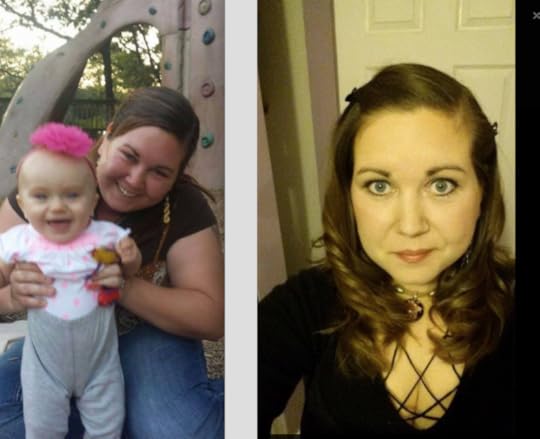
Jessie shared her wonderful story of wheat/grain liberation that allowed weight to drop, dress size to shrink, and boosted energy.
Back in September of 2014 I came across an article a friend of mine posted on Facebook about the dangers of wheat. Curiosity got the best of me and I opened up the article and read it. I couldn’t believe just how bad this was. So I looked to see who she shared it from and saw your page.
I began to read other things you had posted and was astonished by how removing something like wheat from your diet could be so beneficial. So I thought, hey it’s worth trying to see what kind of results I got.
Within the first couple weeks, I dropped about 10 pounds and I started to have an immense amount of energy. I started to use my step counting app to see if I could reach or get close to 10,000 steps a day. I’ve never felt so motivated. I started drinking at least 3 liters of water a day, switched to good oils, and cooked an omelet with veggies and cheese for breakfast, raw veggies, nuts and cheese for lunch, and meat and vegetables for dinner. I cut out refined sugar but would, once in a while, have some dark chocolate.
Within a couple of months, I lost over 20 pounds. It is now March 2015. I have lost 46 pounds and went from a size 16 to a size 6. I have been slowly decreasing my anxiety/bipolar medications. Getting healthy showed me I have a passion for living this way and I will be studying natural medicine and nutrition. Before I could never keep an interest very long, although there are many things I have a talent for. I am eager to learn and happier than I have ever been. Wheat belly (I bought the book too and LOVED IT!) has changed my life for the better in so many ways.
Isn’t that great? I hear this a lot on the Wheat Belly lifestyle: the upfront results are so encouraging that people are motivated to take on more health practices, such as exercise. They also lose joint discomfort and muscle stiffness, gain new energy, all adding up to wanting to tackle new health and life challenges. Yes: you lose weight on the Wheat Belly lifestyle, but you gain SO much more by ridding your body of the perfect chronic poisons in wheat and grains.
The post Jessie: Single-digit sizes with Wheat Belly appeared first on Dr. William Davis.
March 4, 2015
Ashley: now pain-free and slender on the Wheat Belly lifestyle
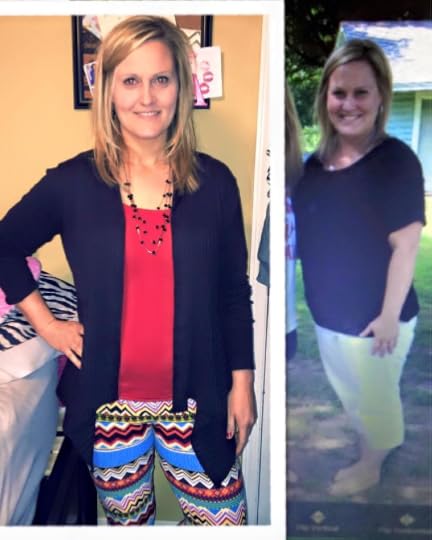
Ashley turned her life and health around by following the Wheat Belly lifestyle. Not only is she now 60 pounds lighter, but has experienced dramatic relief from a list of health problems.
I’ve been debating on posting my picture. But I want to share my story so bad!
In September 2014, I weighed 211 pounds. I was miserable. My lab work had come back and at age 32 I had problems that I shouldn’t have. I was on so much medication. I had debilitating migraines, very high blood pressure, I was borderline type 2 diabetic and on 1500 mg of metformin. My back and joints hurt all over. I couldn’t stand or walk for long periods of time without my feet killing me. I was convinced I needed back surgery from the severity of my pain. An orthopedic surgeon said there wasn’t anything wrong with my back. I had severe acid reflux. I was downright miserable.
After leaving my doctor visit the last week of September, I went and bought the Wheat Belly book. I started immediately, cut wheat/flour and sugar cold turkey. By Christmas I had lost 40 pounds. Today, I left the doctor medication-free with a current weight loss of 60 pounds.
I feel like a new person. I don’t have headaches anymore, I don’t have pain in my joints, I feel like I have a new back–I could do cartwheels! I sleep all night, every problem I had is gone. I have friends message me daily asking me what I’m doing and to please help them. I love adding them to this [Facebook] page so they can see stories like this and before and after pics to help encourage them!
Had Ashley not discovered the power of the Wheat Belly lifestyle, imagine what would have become of her: medications for migraines, medications for joint pain, drugs and insulin for diabetes, impaired activity from pain, complications of diabetes, side-effects of medication, etc.–a fairly bleak future filled with all the “solutions” modern healthcare has to offer.
Instead, she is freed of all these problems just by making some simple changes in her choice of foods. I’ve said it before and I’ll say it again: the Wheat Belly lifestyle is not just another low-carb diet, it is not a gluten-free diet, it is not just cutting calories. Wheat Belly applies anthropological, biological, and scientific evidence that points at wheat and grains as the most destructive “foods” added to the human dietary experience with effects now amplified due to changes introduced by Big Agribusiness. Understand this simple fact and you can be freed of an astounding number of health issues, just as Ashley was.
The post Ashley: now pain-free and slender on the Wheat Belly lifestyle appeared first on Dr. William Davis.
March 1, 2015
The Wheat Belly Total Health Public TV Special airing nationwide!
 Wheat Belly Total Health public television special
Wheat Belly Total Health public television specialThe Wheat Belly Total Health Public TV Special will be aired over 300 times nationwide between March 1 and March 14, 2015.
This is a terrific opportunity to get any naysayers to watch and hear the rational behind this empowering lifestyle. Time and again, people say: “Once I heard the arguments for why this lifestyle works, I was convinced.”
As many of you appreciate, people sometimes dismiss the Wheat Belly lifestyle as another low-carb diet or a gluten-free message. Of course, the Wheat Belly lifestyle is about understanding how and why wheat and grain elimination is THE most important strategy for health to have come along in the last 10,000 years!
Check your local PBS listings for time and station, often posted on your station’s website.
The post The Wheat Belly Total Health Public TV Special airing nationwide! appeared first on Dr. William Davis.
Dr. Davis Infinite Health Blog
Recognize that this i The insights and strategies you can learn about in Dr. Davis' Infinite Health Blog are those that you can put to work to regain magnificent health, slenderness, and youthfulness.
Recognize that this is NOT what your doctor or the healthcare system provides, as they are mostly interested in dispensing pharmaceuticals and procedures to generate revenues. The healthcare INDUSTRY is not concerned with health--you must therefore take the reins yourself.
Dr. Davis focuses on:
--Real, powerful nutritional strategies
--Addresing nutrient deficiencies unique to modern lifestyles
--Deep insights into rebuilding the microbiome disrupted by so many modern factors
Follow Dr. Davis here and on social media and you can witness the extraordinary successes people enjoy on his programs. ...more
- William Davis's profile
- 159 followers



